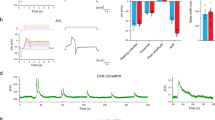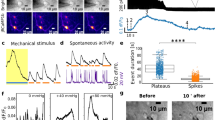Abstract
How different are the neuronal circuits for a given behavior across individual animals? To address this question, we measured multiple cellular and synaptic parameters in individual preparations to see how they correlated with circuit function, using neurons and synapses in the pyloric circuit of the stomatogastric ganglion of the crab Cancer borealis. There was considerable preparation-to-preparation variability in the strength of two identified synapses, in the amplitude of a modulator-evoked current and in the expression of six ion channel genes. Nonetheless, we found strong correlations across preparations among these parameters and attributes of circuit performance. These data illustrate the importance of making multidimensional measurements from single preparations for understanding how variability in circuit output is related to the variability of multiple circuit parameters.
This is a preview of subscription content, access via your institution
Access options
Subscribe to this journal
Receive 12 print issues and online access
$209.00 per year
only $17.42 per issue
Buy this article
- Purchase on Springer Link
- Instant access to full article PDF
Prices may be subject to local taxes which are calculated during checkout





Similar content being viewed by others
References
Prinz, A.A., Bucher, D. & Marder, E. Similar network activity from disparate circuit parameters. Nat. Neurosci. 7, 1345–1352 (2004).
Goldman, M.S., Golowasch, J., Marder, E. & Abbott, L.F. Global structure, robustness and modulation of neuronal models. J. Neurosci. 21, 5229–5238 (2001).
Achard, P. & De Schutter, E. Complex parameter landscape for a complex neuron model. PLoS Comput. Biol. 2, e94 (2006).
Marder, E. & Goaillard, J.M. Variability, compensation and homeostasis in neuron and network function. Nat. Rev. Neurosci. 7, 563–574 (2006).
Swensen, A.M. & Bean, B.P. Robustness of burst firing in dissociated purkinje neurons with acute or long-term reductions in sodium conductance. J. Neurosci. 25, 3509–3520 (2005).
Golowasch, J., Abbott, L.F. & Marder, E. Activity-dependent regulation of potassium currents in an identified neuron of the stomatogastric ganglion of the crab Cancer borealis. J. Neurosci. 19, RC33 (1999).
Schulz, D.J., Goaillard, J.M. & Marder, E. Variable channel expression in identified single and electrically coupled neurons in different animals. Nat. Neurosci. 9, 356–362 (2006).
Liss, B. et al. Tuning pacemaker frequency of individual dopaminergic neurons by Kv4.3L and KChip3.1 transcription. EMBO J. 20, 5715–5724 (2001).
Liss, B. & Roeper, J. Correlating function and gene expression of individual basal ganglia neurons. Trends Neurosci. 27, 475–481 (2004).
MacLean, J.N. et al. Activity-independent coregulation of IA and Ih in rhythmically active neurons. J. Neurophysiol. 94, 3601–3617 (2005).
Schulz, D.J., Goaillard, J.M. & Marder, E.E. Quantitative expression profiling of identified neurons reveals cell-specific constraints on highly variable levels of gene expression. Proc. Natl. Acad. Sci. USA 104, 13187–13191 (2007).
Marder, E. & Bucher, D. Understanding circuit dynamics using the stomatogastric nervous system of lobsters and crabs. Annu. Rev. Physiol. 69, 291–316 (2007).
Eisen, J.S. & Marder, E. A mechanism for production of phase shifts in a pattern generator. J. Neurophysiol. 51, 1375–1393 (1984).
Harris-Warrick, R.M., Coniglio, L.M., Barazangi, N., Guckenheimer, J. & Gueron, S. Dopamine modulation of transient potassium current evokes phase shifts in a central pattern generator network. J. Neurosci. 15, 342–358 (1995).
Harris-Warrick, R.M., Coniglio, L.M., Levini, R.M., Gueron, S. & Guckenheimer, J. Dopamine modulation of two subthreshold currents produces phase shifts in activity of an identified motoneuron. J. Neurophysiol. 74, 1404–1420 (1995).
Thuma, J.B., Harness, P.I., Koehnle, T.J., Morris, L.G. & Hooper, S.L. Muscle anatomy is a primary determinant of muscle relaxation dynamics in the lobster (Panulirus interruptus) stomatogastric system. J. Comp. Physiol. A Neuroethol. Sens. Neural Behav. Physiol. 193, 1101–1113 (2007).
Golowasch, J. & Marder, E. Ionic currents of the lateral pyloric neuron of the stomatogastric ganglion of the crab. J. Neurophysiol. 67, 318–331 (1992).
Taylor, A.L., Goaillard, J.M. & Marder, E. How multiple conductances determine electrophysiological properties in a multicompartmental model. J. Neurosci. 29, 5573–5586 (2009).
Eisen, J.S. & Marder, E. Mechanisms underlying pattern generation in lobster stomatogastric ganglion as determined by selective inactivation of identified neurons. III. Synaptic connections of electrically coupled pyloric neurons. J. Neurophysiol. 48, 1392–1415 (1982).
Marder, E. & Eisen, J.S. Transmitter identification of pyloric neurons: electrically coupled neurons use different neurotransmitters. J. Neurophysiol. 51, 1345–1361 (1984).
Hooper, S.L. & Marder, E. Modulation of the lobster pyloric rhythm by the peptide proctolin. J. Neurosci. 7, 2097–2112 (1987).
Miller, J.P. Pyloric mechanisms. in The Crustacean Stomatogastric System (eds. Selverston, A.I. & Moulins, M.) 109–145 (Springer-Verlag, Berlin, 1987).
Thirumalai, V., Prinz, A.A., Johnson, C.D. & Marder, E. Red pigment concentrating hormone strongly enhances the strength of the feedback to the pyloric rhythm oscillator but has little effect on pyloric rhythm period. J. Neurophysiol. 95, 1762–1770 (2006).
Nadim, F., Manor, Y., Kopell, N. & Marder, E. Synaptic depression creates a switch that controls the frequency of an oscillatory circuit. Proc. Natl. Acad. Sci. USA 96, 8206–8211 (1999).
Nusbaum, M.P., Blitz, D.M., Swensen, A.M., Wood, D. & Marder, E. The roles of co-transmission in neural network modulation. Trends Neurosci. 24, 146–154 (2001).
Swensen, A.M. & Marder, E. Multiple peptides converge to activate the same voltage-dependent current in a central pattern-generating circuit. J. Neurosci. 20, 6752–6759 (2000).
Swensen, A.M. & Marder, E. Modulators with convergent cellular actions elicit distinct circuit outputs. J. Neurosci. 21, 4050–4058 (2001).
Golowasch, J. & Marder, E. Proctolin activates an inward current whose voltage dependence is modified by extracellular Ca2+. J. Neurosci. 12, 810–817 (1992).
Weimann, J.M. et al. Modulation of oscillator interactions in the crab stomatogastric ganglion by crustacean cardioactive peptide. J. Neurosci. 17, 1748–1760 (1997).
MacLean, J.N., Zhang, Y., Johnson, B.R. & Harris-Warrick, R.M. Activity-independent homeostasis in rhythmically active neurons. Neuron 37, 109–120 (2003).
Lüthi, A. & McCormick, D.A. H-current: properties of a neuronal and network pacemaker. Neuron 21, 9–12 (1998).
Norris, B.J., Weaver, A.L., Wenning, A., Garcia, P.S. & Calabrese, R.L. A central pattern generator producing alternative outputs: pattern, strength and dynamics of premotor synaptic input to leech heart motor neurons. J. Neurophysiol. 98, 2992–3005 (2007).
Norris, B.J., Weaver, A.L., Wenning, A., Garcia, P.S. & Calabrese, R.L. A central pattern generator producing alternative outputs: phase relations of leech heart motor neurons with respect to premotor synaptic input. J. Neurophysiol. 98, 2983–2991 (2007).
Bucher, D., Prinz, A.A. & Marder, E. Animal-to-animal variability in motor pattern production in adults and during growth. J. Neurosci. 25, 1611–1619 (2005).
Prinz, A.A., Thirumalai, V. & Marder, E. The functional consequences of changes in the strength and duration of synaptic inputs to oscillatory neurons. J. Neurosci. 23, 943–954 (2003).
van Welie, I., van Hooft, J.A. & Wadman, W.J. Homeostatic scaling of neuronal excitability by synaptic modulation of somatic hyperpolarization-activated Ih channels. Proc. Natl. Acad. Sci. USA 101, 5123–5128 (2004).
Lien, C.C. & Jonas, P. Kv3 potassium conductance is necessary and kinetically optimized for high-frequency action potential generation in hippocampal interneurons. J. Neurosci. 23, 2058–2068 (2003).
Tierney, A.J. & Harris-Warrick, R.M. Physiological role of the transient potassium current in the pyloric circuit of the lobster stomatogastric ganglion. J. Neurophysiol. 67, 599–609 (1992).
Rabbah, P. & Nadim, F. Distinct synaptic dynamics of heterogeneous pacemaker neurons in an oscillatory network. J. Neurophysiol. 97, 2239–2253 (2007).
Greenspan, R.J. The flexible genome. Nat. Rev. Genet. 2, 383–387 (2001).
Chouard, T. Darwin 200: beneath the surface. Nature 456, 300–303 (2008).
Hooper, S.L. et al. The innervation of the pyloric region of the crab, Cancer borealis: homologous muscles in decapod species are differently innervated. J. Comp. Physiol. [A] 159, 227–240 (1986).
Weimann, J.M., Meyrand, P. & Marder, E. Neurons that form multiple pattern generators: identification and multiple activity patterns of gastric/pyloric neurons in the crab stomatogastric system. J. Neurophysiol. 65, 111–122 (1991).
Buchholtz, F., Golowasch, J., Epstein, I.R. & Marder, E. Mathematical model of an identified stomatogastric ganglion neuron. J. Neurophysiol. 67, 332–340 (1992).
Acknowledgements
We thank S.R. Pulver and L.S. Tang for contributing data. This work was supported by US National Institutes of Health grants NS17813 (E.M.), MH46742 (E.M.) and NS50928 (A.L.T.), James S. McDonnell Foundation grant 220020065 (E.M.) and National Science Foundation grant IOB-0615160 (D.J.S.).
Author information
Authors and Affiliations
Contributions
J.-M.G. conducted the majority of the electrophysiological experiments, analyzed data and contributed to writing the manuscript. A.L.T. analyzed data, conducted experiments and contributed to writing the manuscript. D.J.S. performed all of the quantitative single-cell PCR. E.M. supervised the experiments and contributed to writing the manuscript.
Corresponding author
Supplementary information
Supplementary Text and Figures
Supplementary Figures 1–3 (PDF 859 kb)
Rights and permissions
About this article
Cite this article
Goaillard, JM., Taylor, A., Schulz, D. et al. Functional consequences of animal-to-animal variation in circuit parameters. Nat Neurosci 12, 1424–1430 (2009). https://doi.org/10.1038/nn.2404
Received:
Accepted:
Published:
Issue Date:
DOI: https://doi.org/10.1038/nn.2404
This article is cited by
-
A biophysical perspective on the resilience of neuronal excitability across timescales
Nature Reviews Neuroscience (2023)
-
Degeneracy in epilepsy: multiple routes to hyperexcitable brain circuits and their repair
Communications Biology (2023)
-
A new reduced-morphology model for CA1 pyramidal cells and its validation and comparison with other models using HippoUnit
Scientific Reports (2021)
-
Neural Mechanisms That Hide Individual Behavioral Differences: Evidence from Psychophysics and Neuroscience
Computational Brain & Behavior (2020)
-
Heterogeneity within classical cell types is the rule: lessons from hippocampal pyramidal neurons
Nature Reviews Neuroscience (2019)



